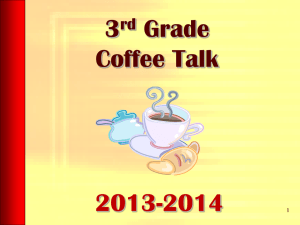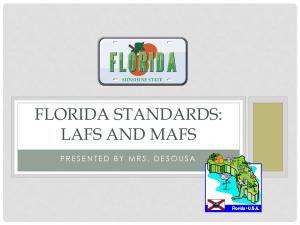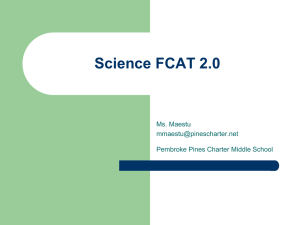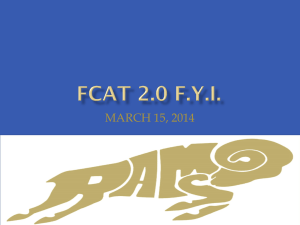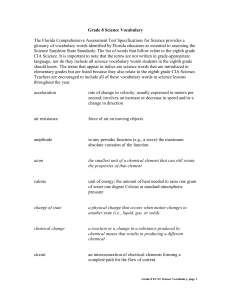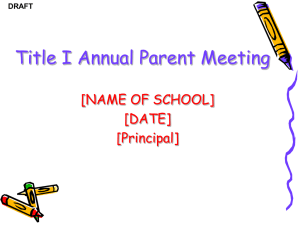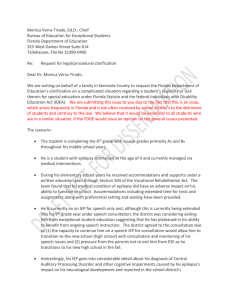science sample test & answer book - K
advertisement
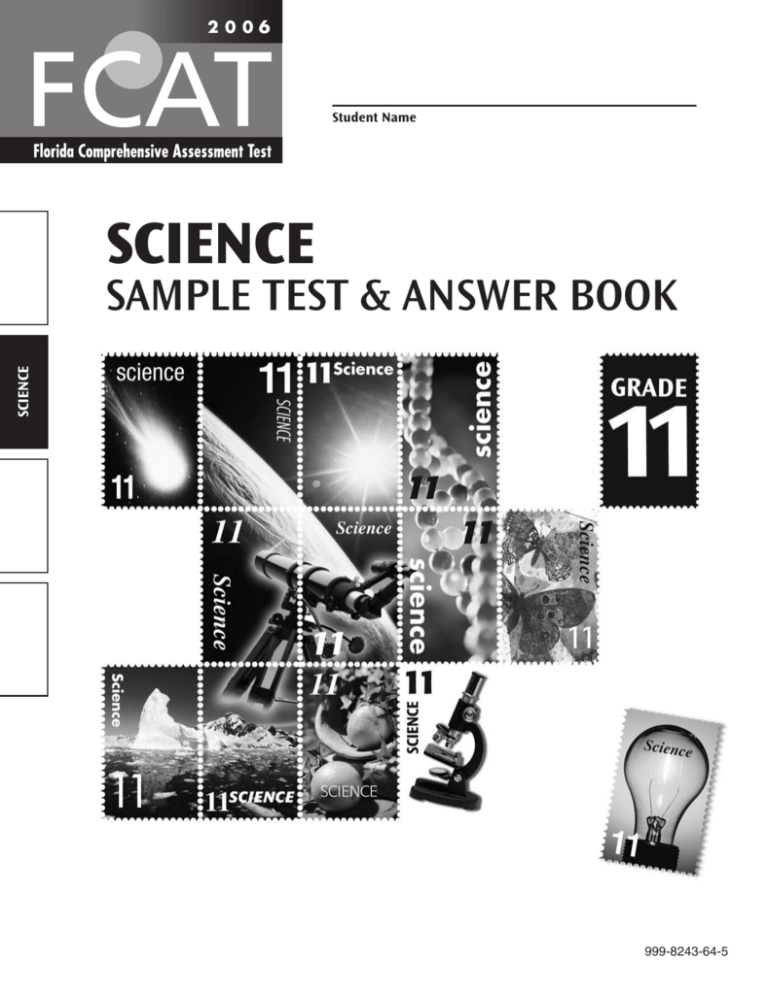
Student Name SCIENCE SCIENCE SAMPLE TEST & ANSWER BOOK 999-8243-64-5 FCAT Sample Test Materials These sample test materials are designed to help you prepare to answer FCAT questions. These materials introduce you to the kinds of questions you will answer when you take FCAT and include hints for responding to the different kinds of FCAT questions. The FCAT Science sample test materials for Grade 11 are composed of the books described below: ✓ Sample Test and Answer Book Includes a science sample test, a sample answer book, and instructions for completing the sample test. (Copies are available for all students in the tested grade.) Sample Answer Key Includes answers and explanations for the questions in the sample test. (Copies are available for classroom teachers only.) ✓ = This book Copyright Statement for This Assessment and School Performance Publication Authorization for reproduction of this document is hereby granted to persons acting in an official capacity within the Uniform System of Public K–12 Schools as defined in Section 1000.01(4), Florida Statutes. The copyright notice at the bottom of this page must be included in all copies. All trademarks and trade names found in this publication are the property of their respective owners and are not associated with the publishers of this publication. Permission is NOT granted for distribution or reproduction outside of the Uniform System of Public K–12 Schools or for commercial distribution of the copyrighted materials without written authorization from the Florida Department of Education. Questions regarding use of these copyrighted materials should be sent to the following: The Administrator Assessment and School Performance Florida Department of Education Tallahassee, Florida 32399-0400 Copyright © 2005 State of Florida Department of State FCAT Science Sample Test Book SAMPLE 11 Calculator Instructions . . . . . . . . . . . . . . . . . . . . . . . . . . . . . . . . . . . . . . Page 2 A calculator is provided for you to use during the test. This section provides helpful hints for using a calculator on the test. Gridded-Response Instructions . . . . . . . . . . . . . . . . . . . . . . . . . . . . . . Page 3 Some FCAT Science questions require you to provide your answers by filling in numeric grids. This section shows different ways of completing the response grids correctly. Taking the FCAT Science Sample Test . . . . . . . . . . . . . . . . . . . . . . . . Page 7 This section introduces the FCAT Science Sample Test. It includes a description of the different kinds of questions on the FCAT, hints for answering FCAT Science questions, and an estimate of the time required to complete the sample test. FCAT Science Sample Test . . . . . . . . . . . . . . . . . . . . . . . . . . . . . . . . . . Page 9 The Science Sample Test consists of 15 practice questions that are similar to questions on the FCAT. It includes a perforated (tear-out) Science Reference Sheet and Periodic Table found on page 11 and page 12. FCAT Science Sample Answer Book . . . . . . . . . . . . . . . . . . . . . . . . . Page 23 Your answers to the sample test questions should be placed in the Science Sample Answer Book. The answer book is perforated and may be removed before you start the sample test. Page 1 FCAT 2006 Sample Test Materials © 2005 Florida Department of Education Calculator Instructions This is a picture of a generic calculator and its parts. GENERIC MODEL Solar Cell Memory Indication Negative Sign Display Error Indication Memory Keys On/Clear Sign Change Percent ON/C MRC + M– OFF Off – 7 8 9 ÷ Division % 4 5 6 ✕ Multiplication 1 2 3 – Subtraction 0 • = + Addition Square Root Clear Entry M+ CE Equal Sign Decimal Point HELPFUL HINTS FOR TAKING THE FCAT SCIENCE TEST 1. Read the problem very carefully. Then decide whether or not you need the calculator to help you solve the problem. 2. When starting a new problem, always clear your calculator by pressing the clear key. 3. If you see an E in the display, clear the error before you begin. 4. If you see an M in the display, clear the memory and the calculator before you begin. 5. If the number in the display is not one of the answer choices, check your work. Remember that when computing with certain types of fractions, you may have to round the number in the display. 6. Remember, your calculator will NOT automatically perform the algebraic order of operations. 7. Calculators might display an incorrect answer if you press the keys too quickly. When working with calculators, use careful and deliberate keystrokes, and always remember to check your answer to make sure that it is reasonable. 8. The negative sign may appear either to the left or to the right of the number. 9. Always check your answer to make sure that you have completed all of the necessary steps. Page 2 FCAT 2006 Sample Test Materials © 2005 Florida Department of Education How to Complete the Response Grids Science test questions with this symbol require that you fill in a grid in your answer book. There may be more than one correct way to fill in a response grid. This section shows you different ways the response grid may be completed. Parts of a Response Grid For Grade 11, response grids have the following parts: answer boxes fraction bar decimal point number bubbles Directions 1. Work the problem and find an answer or solution. 2. Write your answer in the answer boxes at the top of the grid. • Print your answer with the first digit in the left answer box, OR with the last digit in the right answer box. • Print only one digit or symbol in each answer box. Do NOT leave a blank answer box in the middle of an answer. • Be sure to write a decimal point or fraction bar in the answer box if it is a part of the answer. Page 3 FCAT 2006 Sample Test Materials © 2005 Florida Department of Education Page 4 FCAT 2006 Sample Test Materials © 2005 Florida Department of Education Page 5 FCAT 2006 Sample Test Materials © 2005 Florida Department of Education Page 6 FCAT 2006 Sample Test Materials © 2005 Florida Department of Education Taking the FCAT Science Sample Test Hints for Taking the FCAT Science Test Here are some hints to help you do your best when you take the FCAT Science test. Keep these hints in mind when you answer the sample questions. ✓ Learn how to answer each kind of question. The FCAT Science test for Grade 11 has four types of questions: multiple-choice, gridded-response, short-response, and extended-response. ✓ Read each question carefully. ✓ Check each answer to make sure it is the best answer for the question. ✓ ✓ ✓ ✓ ✓ Answer the questions you are sure about first. If a question seems too difficult, skip it and go back to it later. Be sure to fill in the answer bubbles correctly. Do not make any stray marks around answer spaces. Think positively. Some questions may seem hard to you, but you may be able to figure out what to do if you reread the question carefully. When you have finished each question, reread it to make sure your answer is reasonable. Relax. Some people get nervous about tests. It’s natural. Just do your best. Page 7 FCAT 2006 Sample Test Materials © 2005 Florida Department of Education How to Answer the “Read, Inquire, Explain” Questions Answers to the short- and extended-response problems can receive full or partial credit. You should try to answer these questions even if you are not sure of the correct answer. If a portion of the answer is correct, you may get a portion of the points. ✓ ✓ ✓ Allow about 5 minutes to answer the short “Read, Inquire, Explain” questions and about 10 to 15 minutes to answer the long ones. Read each question carefully. If you do not understand the question, read it again and try to answer one part at a time. ✓ Be sure to answer every part of the question. ✓ Use the information provided to answer the question. ✓ ✓ Write your explanations in clear, concise language. Use only the space provided in the Sample Answer Book. Be sure to keep your writing or drawings inside the box. Reread your explanation to make sure it says what you want it to say. Directions for Taking the Science Sample Test This Sample Test contains the Reference Sheet, the Periodic Table, and 15 science questions. It should take about 30 to 45 minutes to answer all the questions. Mark your answers in the Science Sample Answer Book, which begins on page 23. If you don’t know how to answer a question, just ask your teacher to explain it to you. Your teacher has the answers to the sample questions. You may need formulas or the Periodic Table to help you answer some of the questions. You may refer to the Reference Sheet (page 11) or the Periodic Table (page 12) as often as you like. Use the space in your Science Sample Test Book to do your work on the multiple-choice and gridded-response questions, but be sure to put your answers in the Sample Answer Book. For the “Read, Inquire, Explain” questions, write your answers in the Sample Answer Book. Before you begin, remove the Sample Answer Book by tearing along the dotted line. Page 8 FCAT 2006 Sample Test Materials © 2005 Florida Department of Education FCAT Science Sample Test SAMPLE 11 FCAT Question Symbols READ INQUIRE EXPLAIN This symbol appears next to questions that require short written answers. Use about 5 minutes to answer these questions. A complete and correct answer to each of these questions is worth 2 points. A partially correct answer is worth 1 point. READ INQUIRE EXPLAIN This symbol appears next to questions that require longer written answers. Use about 10 to 15 minutes to answer these questions. A complete and correct answer to each of these questions is worth 4 points. A partially correct answer is worth 1, 2, or 3 points. This symbol appears next to questions that require you to fill in your answer on a grid. There may be more than one correct way to fill in a response grid. You MUST fill in the bubbles accurately to receive credit for your answer. A correct answer to each of these questions is worth 1 point. Page 9 FCAT 2006 Sample Test Materials © 2005 Florida Department of Education BLANK PAGE Page 10 FCAT 2006 Sample Test Materials © 2005 Florida Department of Education Grade 11 FCAT Science Reference Sheet Fold and Tear Carefully Along Dotted Line. Equations Acceleration (a) = change in velocity (m/s) time taken for this change (s) a = vf – vi tf – ti Average speed (v) = distance time v = d t Density (D) = mass (g) Volume (cm3) D = m V Percent Efficiency (e) = Work out (J) × 100 Work in (J) %e = Wout × 100 Win Force (F) = mass (kg) × acceleration (m/s2) F = ma Frequency (f) = number of events (waves) time (s) f = n of events t Momentum (p) = mass (kg) × velocity (m/s) p = mv Pressure (P) = Force (N) area (m2) P = F A Wavelength (λ) = velocity (m/s) frequency (Hz) λ = v f Work (W) = Force (N) × distance (m) W = Fd Units of Measure m = meter cm = centimeter g = gram kg = kilogram s = second Hz = hertz (waves per second) J = joule (newton-meter) N = newton (kilogram-meter per second squared) 1 Astronomical Unit (AU) = distance between Earth and the Sun (approximately 150 million kilometers) Page 11 FCAT 2006 Sample Test Materials © 2005 Florida Department of Education FCAT 2006 Sample Test Materials © 2005 Florida Department of Education Period 7 6 5 4 3 2 1 Mg Ra Radium 226.025 Fr Francium 223 88 87 Ba Barium 137.327 Cs Cesium 132.905 56 55 Sr Strontium 87.62 Rb Rubidium 85.468 38 37 Ac Actinium 227.028 89 La Lanthanum 138.905 57 Y Yttrium 88.906 39 Sc Scandium 44.956 Ca 21 3 3B Calcium 40.078 K Silicon 28.086 Si 14 Rf Rutherfordium (261) 104 Hf Hafnium 178.49 72 Zr Zirconium 91.224 40 Ti Titanium 47.88 22 4 4B Sg Seaborgium (263) 106 W Tungsten 183.85 74 Mo Molybdenum 95.94 42 Cr Chromium 51.996 24 6 6B Bh Bohrium (264) 107 Re Rhenium 186.207 75 Tc Technetium 98 43 Mn Manganese 54.938 25 7 7B Symbol Name Atomic Mass Atomic number Nd Pr U Uranium 238.029 Pa Protactinium 231.036 92 91 Praseodymium Neodymium 140.908 144.24 60 59 Actinide series Thorium 232.038 Th 90 Cerium 140.12 Ce 58 Lanthanide series Inner Transition Metals Db Dubnium (262) 105 Ta Tantalum 180.948 73 Nb Niobium 92.906 41 V Vanadium 50.942 23 5 5B Transition Metals Potassium 39.098 20 19 Magnesium 24.305 Na Sodium 22.990 12 11 Be Li Beryllium 9.012 4 3 Lithium 6.941 2A 2 Hydrogen 1.008 H 1 1 1A Group Sm Np Neptunium 237.048 93 Pu Plutonium 244.064 94 Samarium 150.36 Pm Promethium 144.913 62 Mt Meitnerium (268) 109 Ir Iridium 192.22 77 Rh Rhodium 102.906 45 Cobalt 58.933 Co 27 9 8B 61 Hs Hassium (265) 108 Os Osmium 190.2 76 Ru Ruthenium 101.07 44 Fe Iron 55.847 26 8 (based on Am Americium 243.061 95 Eu Europium 151.96 63 Pt Platinum 195.08 78 Pd Palladium 106.42 46 Ni Nickel 58.693 28 Curium 247.070 Cm 96 Gd Gadolinium 157.25 64 Au Gold 196.967 79 Silver 107.868 Ag 47 Copper 63.546 Cu 29 11 1B = 12.0000) 10 12 6C 50 Sn 49 In Ho Einsteinium 252.083 Es Californium 251.080 Cf Bk Berkelium 247.070 99 98 97 Holmium 164.930 Dy Dysprosium 162.50 Terbium 158.925 Tb 67 66 65 Lead 207.2 Pb Tl Thallium 204.383 Mercury 200.59 Hg 82 81 80 Tin 118.710 Indium 114.82 Cadmium 112.411 Cd Ge Germanium 72.61 48 Gallium 69.723 Ga Zinc 65.39 Zn 32 Si Silicon 28.086 31 Al Aluminum 26.982 14 13 30 12 2B N Fm Fermium 257.095 100 Er Erbium 167.26 68 Md Mendelevium 258.099 101 Tm Thulium 168.934 69 Po Polonium 208.982 84 Te Tellurium 127.60 52 Se 34 S Sulfur 32.06 16 Oxygen 15.999 O 8 16 6A Selenium 78.96 Metals Bi Bismuth 208.980 83 Sb Antimony 121.757 51 Arsenic 74.922 As 33 P Phosphorus 30.974 15 Nitrogen 14.007 C Carbon 12.011 Boron 10.81 B 7 6 5 15 5A 14 4A 13 3A Representative Elements Periodic Table of the Elements Fold and Tear Carefully Along Dotted Line. Page 12 Nobelium 259.101 No 102 Yb Ytterbium 173.04 70 Radon 222 Rn 86 Xenon 131.29 Xe 54 Kr Krypton 83.80 36 Ar Argon 39.948 18 Neon 20.180 Ne 10 He Helium 4.003 Lr Lawrencium 260.105 103 Lu Lutetium 174.967 71 Nonmetals At Astatine 210 85 I Iodine 126.905 53 Br Bromine 79.904 35 Cl Chlorine 35.453 17 F Fluorine 18.998 9 17 7A 2 18 8A SAMPLE FCAT Science Sample Test Book 11 11_S_STM_01 1 ● The graph below shows a heating curve for water (H2O) in degrees Celsius (°C). Temperature (°C) HEAT CURVE FOR H2O 130 120 T 110 R 100 S 90 80 70 60 50 40 30 20 10 0 A Q –10 P 0 500 1000 1500 2000 2500 3000 3500 Heat added (joules) Which line segment on the heating curve identifies where water changes from a liquid into a gas? A. PQ B. QR C. RS D. ST Page 13 FCAT 2006 Sample Test Materials © 2005 Florida Department of Education Go On SAMPLE 11 FCAT Science Sample Test Book 11_S_STM_02 2 ● Natural diamonds are formed when carbon (C) atoms are forced into a crystal structure under conditions of high temperature and pressure. Nitrogen (N) atoms are sometimes trapped in the carbon crystal spaces. Which property of nitrogen atoms makes it possible for nitrogen to occupy spaces in the crystal structure? F. Nitrogen atoms are colorless. G. Nitrogen is plentiful in Earth’s crust. H. Nitrogen is a gas at room temperature. I. Nitrogen atoms are similar in shape and size to carbon atoms. 11_S_STM_03 3 ● As Carol plays basketball, the ball bounces off the court. After each bounce, the height and energy of the bounce decreases. What is the main reason the bounce height decreases? A. The energy has been released into the surroundings. B. The energy has been recycled into horizontal motion. C. The energy has disappeared due to the force of gravity. D. The energy has been balanced by equal and opposite reactions. Page 14 FCAT 2006 Sample Test Materials © 2005 Florida Department of Education Go On SAMPLE FCAT Science Sample Test Book 11_S_STM_04 4 ● 11 Gravitational force on different objects varies. For example, the acceleration due to gravity on Earth is 9.8 meters per second squared (m/s2). This is 6 times greater than the acceleration due to gravity on the Moon. The weight of an object on Earth, in newtons (N), is found by multiplying the mass of the object by the acceleration due to gravity. An astronaut’s sledgehammer has a mass of 9.0 kilograms (kg) on Earth. What will be the weight, in newtons (N), of the sledgehammer on the Moon? 11_S_STM_05 5 ● Pierre staked a rotary sprinkler into the ground to water his lawn. When the water is turned on, the sprinkler arms rotate as shown below. Rotation of Sprinkler Arm Water Out Water Out Water In Water Out Pierreʼs Rotary Sprinkler Why does the sprinkler rotate when the water rushes out of the three arms? F. The escaping water counteracts the force of gravity on the sprinkler arms. G. The water expands rapidly, causing the arms on the sprinkler to perform work. H. The water spraying outward produces an opposite force on the sprinkler arms. I. The escaping water causes air to rush back and push against the sprinkler arms. Page 15 FCAT 2006 Sample Test Materials © 2005 Florida Department of Education Go On SAMPLE 11 FCAT Science Sample Test Book 11_S_STM_06 6 ● The warm Gulf Stream passes the southern tip of Florida on its way north. How does the warm, moist air associated with this current affect the climate of southern Florida? A. It increases the amount of rainfall. B. It causes prevailing easterly winds. C. It decreases the amount of humidity. D. It causes the skies to clear after sunset. 11_S_STM_07 7 ● Consuela lives on the east coast of Florida. She notices a neap tide occurs twice a month. Neap tides occur when the Sun, the Moon, and Earth are in specific positions. Sun 1 Moon 4 2 Moon Moon Earth 3 Not to Scale Moon Which two of the four Moon positions shown above will cause neap tides? F. positions 1 and 2 G. positions 1 and 3 H. positions 2 and 3 I. positions 2 and 4 Page 16 FCAT 2006 Sample Test Materials © 2005 Florida Department of Education Go On SAMPLE FCAT Science Sample Test Book 11 11_S_STM_08 8 ● The fusion of hydrogen in a star’s core to produce helium generates energy, allowing small- to medium-sized stars like the Sun to burn for billions of years. During which stage do stars produce energy from the fusion of hydrogen into helium? A. blue supergiant B. main sequence C. red shift D. stellar nebulae 11_S_STM_09 9 ● Most organisms cannot survive in temperatures higher than 40 degrees Celsius (°C). When temperatures are sustained above 40°C, the organism’s enzymes become inactive and the organism eventually dies; however, bacteria have been observed to survive in hot springs with temperatures above 40°C. Which of the following is the best explanation for these bacteria surviving at higher temperatures? F. Bacteria can change their genetic material. G. Enzymes are most active at acidic pH levels. H. Enzymes present in the bacteria can tolerate the harsh springs environment. I. Bacteria speed up a chemical reaction that occurs in the springs environment. 11_S_STM_10 10 ● READ INQUIRE EXPLAIN Go to your Sample Answer Book to answer Number 10. Page 17 FCAT 2006 Sample Test Materials © 2005 Florida Department of Education Go On SAMPLE 11 FCAT Science Sample Test Book 11_S_STM_11 11 ● Each year, approximately 5 000 metric tons of mercury compounds are released into the environment either naturally or from human activities. Once mercury enters the water systems, bacteria convert it into an organic form called methylmercury, introducing it into the food web. Which of the following will happen to the methylmercury released into the environment? A. It will be evenly distributed throughout the food web. B. It will be retained only in filter feeders of the aquatic system. C. It will be retained mostly by the producers and herbivores. D. It will have the highest concentration in the large secondary consumers. 11_S_STM_12 12 ● Damon knows that plants are the base for most food chains. He made a list of plant characteristics shown in the chart below. Plant Characteristics Contains chloroplasts Contains rigid cell walls Can have fibrous or tap roots Can have a waxy outer covering Which characteristic from the chart enables these plants to capture the sunlight needed to be a producer? F. Contains chloroplasts G. Contains rigid cell walls H. Can have fibrous or tap roots I. Can have a waxy outer covering Page 18 FCAT 2006 Sample Test Materials © 2005 Florida Department of Education Go On SAMPLE FCAT Science Sample Test Book 11 11_S_STM_13 13 ● Stephen learned that methane (CH4) absorbs about 25 times more infrared radiation than carbon dioxide (CO2). He knew that ice core data could give information about historic atmospheric changes. A table showing ice core data from Antarctica is shown below. METHANE DATA FROM DE08, DE08-2, AND DSS ICE CORES IN ANTARCTICA Concentration of CH4 mixed with Year (A.D.) air in ice core (ppm) Mean ice depth (meters) 1008 0.67 534 1501 0.69 337 1694 0.68 238 1798 0.70 180 1847 0.76 152 1931 1.01 100 1980 1.48 81 Using the ice core data and other data, Stephen made the hypothesis that for every 0.1 parts per million (ppm) increase in the concentration of atmospheric methane, the average temperature of Earth’s polar regions would increase by 0.4°C (degrees Celsius). Based on his hypothesis, what would be the rise in temperature, in °C (degrees Celsius), for the period 1694–1980? 11_S_STM_14 14 ● READ INQUIRE EXPLAIN Go to your Sample Answer Book to answer Number 14. Page 19 FCAT 2006 Sample Test Materials © 2005 Florida Department of Education Go On SAMPLE 11 FCAT Science Sample Test Book 11_S_STM_15 15 ● Gold (Au), silver (Ag), platinum (Pt), and copper (Cu) are metals that are used in manufacturing processes. The table below shows the melting point in degrees Celsius (°C) and density in grams per cubic centimeter (g/cm3) of these metals. METAL DATA Metal Gold Silver Platinum Copper Melting Point (°C) Density (g/cm3) 1063 961 1773 1083 19.31 14.50 21.42 8.96 Which relationship between melting point and density is supported by the data in the chart? A. The melting point is independent of density. B. The melting point decreases as density decreases. C. The densest materials have the lowest melting points. D. The densest materials have the highest melting points. Page 20 FCAT 2006 Sample Test Materials © 2005 Florida Department of Education SAMPLE FCAT Science Sample Test Book 11 STOP This is the end of the Science Sample Test. Until time is called, go back and check your work or answer questions you did not complete. When you have finished, close your Sample Test Book and Sample Answer Book. Page 21 FCAT 2006 Sample Test Materials © 2005 Florida Department of Education BLANK PAGE Page 22 FCAT 2006 Sample Test Materials © 2005 Florida Department of Education Name_______________________________ Fold and Tear Carefully Along Dotted Line. FCAT Science Sample Answer Book SAMPLE 11 Answer all the questions that appear in the Sample Test in this Sample Answer Book. Answer multiple-choice questions by filling in the bubble for the answer you select. Answer gridded-response questions by filling in the correct bubbles. Write your answers to “Read, Inquire, Explain” questions in the space provided. To remove your Sample Answer Book, tear carefully along the dotted line. Page 23 FCAT 2006 Sample Test Materials © 2005 Florida Department of Education Go On SAMPLE 1 ● A 11 B C FCAT Science Sample Answer Book D 4 ● 2 ● F G H I 3 ● A B C D 5 ● F G H I 6 ● A B C D 8 ● A B C D 9 ● F G H I / / / . . . . . 7 ● 0 0 0 0 0 1 1 1 1 1 2 2 2 2 2 3 3 3 3 3 4 4 4 4 4 5 5 5 5 5 6 6 6 6 6 7 7 7 7 7 8 8 8 8 8 9 9 9 9 9 F G H I Page 24 FCAT 2006 Sample Test Materials © 2005 Florida Department of Education Go On SAMPLE FCAT Science Sample Answer Book 10 ● READ INQUIRE EXPLAIN 11 ● 11 Laura has been using an insecticide to control the ant population in her yard. She has used the same brand of insecticide for many years. At first, the insecticide killed many ants; now, it is not as effective. Explain why the insecticide is no longer as effective as it once was. A B C D 12 ● F G H I 13 ● / / / . . . . . Page 25 FCAT 2006 Sample Test Materials © 2005 Florida Department of Education 0 0 0 0 0 1 1 1 1 1 2 2 2 2 2 3 3 3 3 3 4 4 4 4 4 5 5 5 5 5 6 6 6 6 6 7 7 7 7 7 8 8 8 8 8 9 9 9 9 9 Go On SAMPLE 14 ● READ INQUIRE EXPLAIN 11 FCAT Science Sample Answer Book In 1999, some astronomers thought they observed a Jupiter-sized planet outside our solar system orbiting a young star 63 light years from Earth. Later, other astronomers concluded that the planet was actually a giant sunspot rotating around the surface of the young star. Part A What kind of instruments would the astronomers have used to investigate the star and the phantom planet? Describe what kind of research they most likely would have done before concluding they were observing a giant sunspot rather than a large planet. Part B Based on the scientific method, why did the later astronomers probably choose to challenge the first group of astronomers’ finding of the new planet rather than accept it? What had the first group of astronomers most likely done to make it possible for others to disprove the discovery? Page 26 FCAT 2006 Sample Test Materials © 2005 Florida Department of Education Go On SAMPLE FCAT Science Sample Answer Book 15 ● A B C 11 D STOP This is the end of the Science Sample Answer Book. Until time is called, go back and check your work or answer questions you did not complete. When you have finished, close your Sample Test Book and Sample Answer Book. Page 27 FCAT 2006 Sample Test Materials © 2005 Florida Department of Education Notes Page 28 FCAT 2006 Sample Test Materials © 2005 Florida Department of Education Notes Page 29 FCAT 2006 Sample Test Materials © 2005 Florida Department of Education SCIENCE Assessment and School Performance Florida Department of Education Tallahassee, Florida Copyright © 2005 State of Florida Department of State
